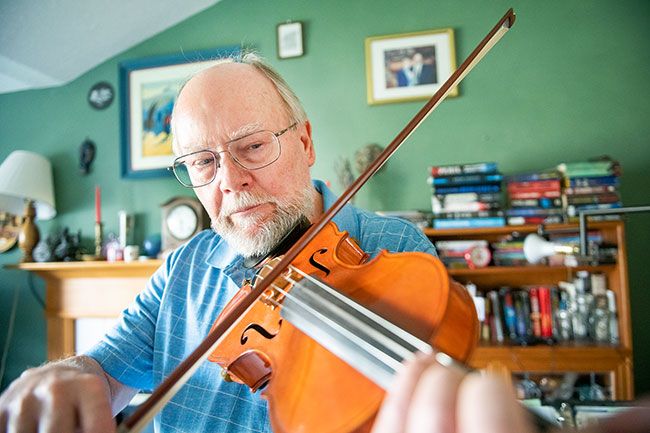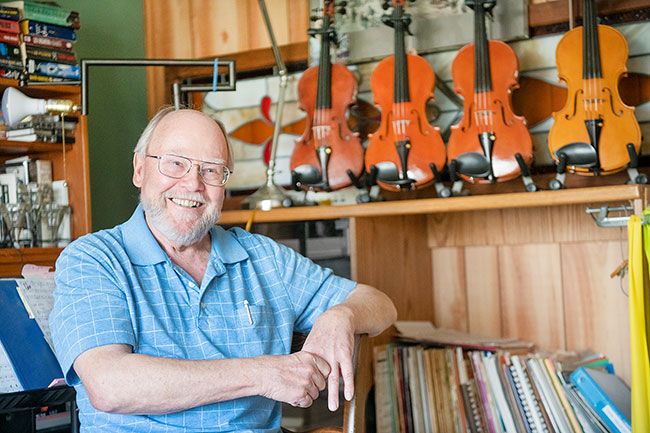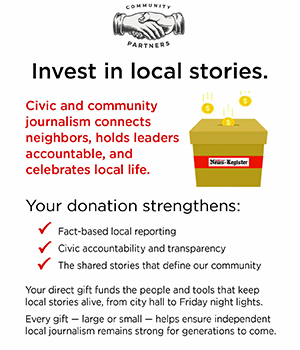Stopping by: Violin maker


Woodworker David Dalton uses the tiniest planer imaginable, not much bigger than the end of his thumb. He needs it for the delicate work of shaving and shaping the smallest pieces of a violin.
He has a large hand planer, too, maybe a foot long. It’s good for the beginning of the violin-making process, when he’s starting with chunks or wedges of maple and spruce that need to be roughed out for the front, back and sides of an instrument.
As the violin progresses, the work becomes more and more delicate. The tiny planer and other specialized tools come into play as he finishes an instrument that weighs just under one pound.
“Making a violin is challenging,” said Dalton. “I like that.”
A former postal employee and commercial fisherman, Dalton lived in the Lincoln City area before moving to McMinnville in 2005.
He chose McMinnville because he was “tired of the wind and wet,” he said, although the extra humidity there didn’t affect his violin making much. (“My violins are fine, but not that fine,” he explained.)
The Willamette Valley offered more opportunities, he said, joking, “I wanted to grow tomatoes.”
He also finds plenty of places for riding his bike on trails such as the one that runs from Banks to Vernonia on an old rail bed.
Dalton was born in England, spent his early years in Toronto, Canada, then moved to Portland in 1959.
As a child, Dalton recalled, he loved the music of the violinists who performed on “The Lawrence Welk Show.” At 7, he asked his mother for violin lessons.
He started with a full-size instrument; today, many children start with smaller violins. He enjoyed playing, although he couldn’t replicate what he heard on TV, he said.
“I still can’t make the Lawrence Welk sound,” he said, although, according to some recent listeners, he was being modest.
He had several different teachers over his first six years. At 13, he put the violin down in favor of other activities. He would be an adult before he picked up the instrument again.
Over the years, he pursued other hobbies instead, including woodworking. He became a skilled carver; some of his dolphin sculptures were in a gallery in Portland, for instance.
He also reproduced parts for vintage furniture, such as knobs on a bed frame, for several Portland antique shops.
About 25 years ago, his interest in music reawakened. He joined the Oregon Coastal Orchestra at Salishan and performed with other groups, as well.
“I always say I play first violin, but I’m second fiddle,” he said, pleased to be able to sit beside great musicians.
And he realized he could adapt his woodworking skills to making instruments. He took a two-week course on the basics of violin making, then set out to teach himself, with books and practice, to master the exacting process.
At one time, he said, “I thought I couldn’t do it. It’s a complicated thing,” he said. But persistence proved otherwise.
Making a musical instrument is satisfying in many ways, he said. While a dolphin sculpture pleases the eye, it’s not “useful.”
“But a violin will be used a lot; every day,” he said. “Someone will be creative with it. That’s fascinating.”
A violin starts out as a tree.
Some people cut their own wood; Dalton orders his from a supply company that offers woods from Europe as well as the U.S.
He likes the species of maple that come from alpine regions, he said. Of the 26 violins he’s completed so far, some are made from Oregon woods, as well.
Each species and each tree produces a different grain, hardness and resonance, he said. Therefore, each violin has different characteristics; some sound more brassy, some more mellow; some produce soft sounds, some ring out to the very last row of the audience — and, in fact, may sound better from farther away.
“Experts can pick the wood for the characteristics they want in the finished violin,” he said. “I just hope for a really good one.”
He added, “I look at the best, the Stradivarius or the Guarneri, and try to do my best.”
Dalton said he learns with each new instrument he makes. He’s proud that his more recent violins sound better than his first ones, and his latest ones sell for thousands of dollars.
Before he starts working with wood, Dalton makes sure he’s in the right mood. If he’s angry, he postpones his project.
“I don’t want to make a mistake,” he explained. “One little slip with a chisel and it can ruin the violin.”
Properly relaxed, Dalton shapes the thin front, usually made of spruce, and the maple back and sides using templates. He glues together sections of the sides, making a frame in the standard violin shape.
“Players usually want the traditional shape,” he said, noting that the shapes of guitars and even violas are more varied.
He carves or chisels the front and back to create slight domes. In earlier centuries, he said, it was common for violin makers to steam the wood, then shape the dome using a mold.
As he works, he said, he may twist the wood to see how it moves, or tap it to see the vibrations. He also uses the Chladni effect, a process that involves spreading glitter or other grains atop the wood, then rapping to see the pattern that’s created; it helps predict the acoustics.
In addition, “it’s part intuition” to find the perfect reverberation, he said.
He likes to find a “really clear sound.”
On the front piece, he cuts out two slender S shapes to create sound holes. He adds a bridge, a fan-like piece that sticks up from the top of the violin to hold the strings above the wood.
He purchases the bridge and the neck of the violin as blanks, or roughly shaped pieces. He carves them to their final thickness before adding them to the violin.
If the bridge is too thick, it will mute the sound, he said. Too thin, and it can bend or break under the tension of the strings.
“You have to find a balance,” he said.
After the body pieces are put together and the neck added, he finishes the violin by adding strings attached to the bridge at one end and to pegs at the top of the violin’s neck.
Then he applies varnish, sometimes seven or eight coats, sometimes 15. The number of layers affects the resonance and, therefore, the sound of the violin.
The perfect amount of varnish is a subject of ongoing debate, as are the types of wood, the height of the bridge, the size of the tone holes, the type of glue that’s used and other aspects.
“That’s what’s fun about violins,” he said. “People will argue about everything.”
There’s no single right answer, he said.
“You can talk to scientists, but there are so many theories,” he said. “And people have different ears. What you like might not be what I like.”
His preference? “A real clear sound, kinda mellow.”
But even that may be tricky to identify.
He recalled sitting in an orchestra next to a woman whose violin sounded okay, but not special. Later, he heard her violin from a distance while sitting in the audience, and it sounded magnificent — to him, at least; someone else might not have enjoyed it.
“A violin may even sound different to the audience than it does to the player,” he said.
When he finishes building a violin, a process that can take more than 200 hours over the course of a year, he’s ready for one of the most rewarding parts of the process: Test playing.
“The satisfying part is the finished product,” he said. “To be able to play it, and to pass it on to someone else to play.”
He is proud to say that some of his violins are played by musicians in Peru whom he’s known since they were children. He has visited the city of Trujillo several times over the years to donate violins and help with music programs.
One boy, now 18, played a Dalton instrument when he auditioned for his college music program. He would like to be a professional violinist someday.
Very satisfying, the McMinnville man said. But just the making is satisfying, too.
Although he’s retired, Dalton does a lot of work on his computer, including maintaining his website, ddaltonviolins.com. Technology can be frustrating, he said.
It’s a welcome relief to walk into his workshop, or to pick up one of the violins he keeps on display in his living room, along with music stands and sheets of Irish dance tunes, classics and other pieces.
“Being able to make something with my hands is really satisfying,” he said. “Being able to make music … it’s part of my life; it’s all encompassing.
“To play, or to make an instrument gives me peace,” he said.
Starla Pointer, who believes everyone has an interesting story to tell, has been writing the weekly “Stopping By” column since 1996. She’s always looking for suggestions. Contact her at 503-687-1263 or spointer@newsregister.com.
CUTLINE












Comments